#duke of angouleme
Explore tagged Tumblr posts
Text
"[Capello] said the King is already tired to satiety of this new Queen (che il Re era stufo et satio hormai de questa nova regina.)" 'Venice: June 1535', in Calendar of State Papers Relating To English Affairs in the Archives of Venice, Volume 5, 1534-1554, (London, 1873) pp. 23-28. British History Online
+
The Lady has lately feasted him at one of her residences, where she prepared beforehand an entertainment [...] to which many people were invited, though she entirely forgot to ask the French ambassador, who has not been at all pleased at her neglect. She has, however, so well managed to banquet and amuse her guests that [...] the King loves his concubine now more than ever he did. 'Spain: June 1535, 16-30', in Calendar of State Papers, Spain, Volume 5 Part 1, 1534-1535, (London, 1886) pp. 492-506. British History Online
#primary sources#i can't tell if chapuys is being sarcastic here lol#(insofar as the french ambassador mention)#if he's not then...yeah. i doubt the easterling story re: her coronation is true#'she entirely forgot' after the french ambassador refused to entertain elizabeth's match with the duke of angouleme#and tried to negotiate one for her stepdaughter instead? i don't think she 'forgot'#i also find it interesting that these are both hostile sources#but the one that will not acknowledge her as queen (granted. the signory acknowledged anne as queen. thus capello does#but certainly charles v didn't and chapuys reflected this)#claims she is more beloved of henry 'than ever'#versus the one that does claims 'tired to satiety'#tl;dr sources that contradict each other always compel me#but esp so when they contradict each other so immediately??#this is literally two reports about the same dynamic same two people in the same month#there's a similar incident of two completely contradicting reports on the state of a marriage much earlier two which reminds me of this#(1510 for hviii and coa)
4 notes
·
View notes
Text
THIS DAY IN GAY HISTOR
based on: The White Crane Institute's 'Gay Wisdom', Gay Birthdays, Gay For Today, Famous GLBT, glbt-Gay Encylopedia, Today in Gay History, Wikipedia, and more … January 6




1367 – Richard II of England (d.1400), born Prince Richard of Bordeaux was the second, but only surviving child, of Edward, Prince of Wales (also known as the Black Prince and the eldest son and heir of King Edward III) and his wife, in Bordeaux, Gascony, where the Black Prince was serving at the time. At the age of four, Richard became second in line to the throne upon the death of his elder brother, Edward of Angouleme, and heir apparent when his father, the Black Prince, died five years later (1376). Richard was dubbed a Knight of the Garter by his grandfather only months before the old king died on June 21, 1377. With the death of Edward III, Richard ascended the throne as King Richard II at the young age of ten.
Richard was deemed fit to govern and a series of councils were set up to conduct business in the king's name for the next three years. When the first of these councils met, not only was John of Gaunt, Richard's powreful uncle left out, but also the king's other remaining uncles, Edmund of Langley and Thomas of Woodstock, the Earls of Cambridge and Buckingham respectively. But although John of Gaunt had no official title in Richard's government, he was to remain a leading and influential political figure for nearly the entire reign, though he and the king would not be without their differences.
The young Richard managed to weather a number of crises, including the Peasant's Revolt at the ripe old age of 14. During the following years, the king gradually came of age and moved closer to reaching his majority reign. It was also during this period that he began to come under the influence of a small group of courtiers that were to greedily consume all of his attentions. This group consisted of three primary figures: Sir Simon Burley, the king's tutor since he was a young child; Michael de la Pole, the king's chancellor and Earl of Suffolk after 1385; and Robert de Vere, Earl of Oxford, whom Richard would ultimately upgrade to Marquis and, soon after, Duke of Ireland.
Richard's close friendship to DeVere was disagreeable to the political establishment. This displeasure was exacerbated by the earl's elevation to the new title of Duke of Ireland in 1386. The chronicler Thomas Walsingham suggested the relationship between the king and DeVere was of a homosexual nature, possibly due to a resentment Walsingham had toward the king.
On top of this, it was also wondered whether Richard was a homosexual since he never bore any children. When thinking of the reign of Richard II, it is difficult not to compare it with that of his great-grandfather, Edward II (another supposed homosexual). Like Edward, Richard had difficulty making decisions for himself and came to be dependent on a small group of favorites for advice, usually bad advice, to run the realm.
This reliance on favorites turned the nobility against him, and he was eventually deposed by Henry IV, and died in captivity in 1400.


1412 – Joan Of Arc, Roman Catholic Saint and national heroine of France (this is a legendary date) (d.1431); Joan wore men's clothing between her departure from Vaucouleurs and her abjuration at Rouen. This raised theological questions in her own era and raised other questions in the twentieth century. The technical reason for her execution was a biblical clothing law. The nullification trial reversed the conviction in part because the condemnation proceeding had failed to consider the doctrinal exceptions to that stricture.
Doctrinally speaking, she was safe to disguise herself as a page during a journey through enemy territory and she was safe to wear armor during battle. The Chronique de la Pucelle states that it deterred molestation while she was camped in the field. Clergy who testified at her rehabilitation trial affirmed that she continued to wear male clothing in prison to deter molestation and rape. Preservation of chastity was another justifiable reason for cross-dressing: her apparel would have slowed an assailant, and men would be less likely to think of her as a sex object in any case.
She referred the court to the Poitiers inquiry when questioned on the matter during her condemnation trial. The Poitiers record no longer survives but circumstances indicate the Poitiers clerics approved her practice. In other words, she had a mission to do a man's work so it was fitting that she dress the part. She also kept her hair cut short through her military campaigns and while in prison. Her supporters, such as the theologian Jean Gerson, defended her hairstyle, as did Inquisitor Brehal during the Rehabilitation trial.
Because Joan wore men's clothes and armor, scholars have speculated about her gender identity and sexuality. Did Joan wear male apparel because she was transgendered? Or did she do so in order to be taken seriously by the men whose support she needed to carry out the orders given by her visions? Was Joan a lesbian or bisexual, if those English terms may be applicable to a French woman living almost six hundred years ago? What relationship did her gender expression have with her sexuality? What about Joan's emphasis throughout her life on her virginity?
It is difficult adequately to address these personal issues based on the historical evidence that we now possess. It is clear, however, that Joan's cross-dressing was a significant part of her life, and that as a cross-dressed warrior and military leader she was venerated by French royalty, soldiery, and peasantry alike.


1854 – English fictional detective, born; What!? Sherlock Holmes? Why include the famous, hawk-nosed detective, a figment of Sir Arthur Conan Doyle's fertile imagination? Why? Because almost no one realizes that Sherlock Holmes, whom his creator almost named "Sherinford," was Gay.
He was, of course, the first consulting detective, a vocation he followed for 23 years. In January 1881, he was looking for someone to share his new digs at 221B Baker Street, and there being no personal ads in the Village Voice or The Advocate (remember those?) in those days, a friend introduced him to Dr. John H. Watson.
Before agreeing to share the flat, the two men, immediately attracted to one another, listed their respective character deficiencies. Holmes admitted to smoking a smelly pipe, although he didn't mention that he was a frequent user of cocaine. Watson owned up to a peculiar habit of leaving his bed at odd hours of the night.
"I have another set of vices," he admitted, but, then, so did Sherlock. The two became friends and roommates for the rest of their lives. For the sordid details of the famous marriage of true minds that followed, read Rex Stout's astonishing "Watson Was Woman," in which the famous creator of Nero Wolfe (himself hardly a paragon of butch studliness) reveals that Watson and Holmes were the most extraordinary Gay team in sleuthing history.
In 1971, The Traveller's Companion, Inc., an affiliate of Olympia Press, published a book based on the assumption that Holmes and Watson were lovers: The Sexual Adventures of Sherlock Holmes. Claiming to be from a newly-discovered secret cache of John Watson's papers, the book retells, very erotically, some of the original stories. It is hard-core gay porn at its best!


1961 – Bill Hayes is an American non-fiction writer and photographer. He has written four books – Sleep Demons, Five Quarts, The Anatomist, and Insomniac City – and has produced one book of photography, How New York Breaks Your Heart. His freelance writing has appeared in a number of periodicals, most notably The New York Times.
Hayes was born in Minneapolis, Minnesota, the fifth of six children, five of them girls. He remains close with his sisters. His mother Jean was an artist; his father John a military man who had lost an eye as a paratrooper in the Korean War. When Bill was three, the family moved to Spokane, Washington, where his father bought a Coca-Cola bottling plant. His mother opened an art school, where Hayes learned to develop and print film. Hayes was close with his maternal grandmother, Helen, from the age of eleven until he left home for college. In high school, Hayes was drawn to the writing of Joan Didion. Hayes attended Santa Clara University in California.
Hayes knew he was gay at a young age, though he had relationships with women in high school and college. He came out at age 24, and considers his orientation to be a core part of his identity.
Hayes' father never accepted him as a gay man and did not maintain a relationship with him, but when John Hayes developed dementia, he came to believe Bill was an old Army friend, and spoke with him warmly. Bill's mother also suffered with dementia until her death in 2011.
Hayes lived in San Francisco for many years, where he worked at the San Francisco AIDS Foundation. His partner of sixteen years was HIV-positive. In 2009, Hayes moved to New York City, where he had a relationship with neurologist and writer Oliver Sacks, until the latter's death in 2015. Hayes' experiences in New York and his six-year relationship with Sacks are the subject of his book Insomniac City.
Hayes has described his adult life as "colored by death" – the deaths he dealt with in his AIDS Foundation work, the sudden death of his longtime partner in San Francisco, and later the death of his partner Oliver Sacks.


1965 – Bjørn Lomborg is a Danish author and adjunct professor at the Copenhagen Business School as well as President of the Copenhagen Consensus Center. He is former director of the Danish government's Environmental Assessment Institute (EAI) in Copenhagen. He became internationally known for his best-selling and controversial book, The Skeptical Environmentalist (2001), in which he argues that many of the costly measures and actions adopted by scientists and policy makers to meet the challenges of global warming will ultimately have minimal impact on the world’s rising temperature.
Lomborg spent a year as an undergraduate at the University of Georgia, earned an M.A. degree in political science at the University of Aarhus in 1991, and a Ph.D. degree in political science at the University of Copenhagen in 1994.
Lomborg is gay and a vegetarian. As a public figure he has been a participant in information campaigns in Denmark about homosexuality, and states that "Being a public gay is to my view a civic responsibility. It's important to show that the width of the gay world cannot be described by a tired stereotype, but goes from leather gays on parade-wagons to suit-and-tie yuppies on the direction floor, as well as everything in between".


1968 – Today is the birthday of the Hungarian politician Gábor Szetey. Szetey is the former Secretary of State for Human Resources, a role he held since July 2006. He is a member of the Hungarian Socialist Party.
Szetey publicly declared that he was gay at the opening night of Budapest's Gay and Lesbian Film Festival, on July 6, 2007. He is the first LGBT member of government in Hungary, and the second politician to come out, after Klára Ungár. Szetey's coming out came at the end of a speech on equality and tolerance:
"When we can be proud of being Hungarian, Romanian, Jewish, Catholic, Gay or Straight... If we can be proud of our differences, we will be proud of our similarities. I believe in God. And I believe that all men and women have the right to love and be loved. Everywhere. Love has no party preference. Neither does happiness or choosing a partner. So: I am Szetey Gábor . I am European, and Hungarian. I believe in God, love, freedom, and equality. I am the Human Resources Secretary of State of the Government of the Republic of Hungary. Economist and HR director. Partner, friend, sometimes rival. And I am Gay."
!n the audience was Klára Dobrev, the wife of Prime Minister Ferenc Gyurcsány, as well as four other members of the Hungarian cabinet. The Prime Minister supported Szetey on his blog and called for public debate about same-sex relationships in Hungary. Hungary currently recognises same-sex registered partnerships. After the coming out of Mr. Szetey, the Parliament adopted the Registered Civil Union Act, which came into force 1 January 2009.
In a subsequent interview, Szetey declared:
"There is a small but vocal group of right-wing extremists which is intent on offending everyone... According to a survey, 51 percent of the respondents thought my speech was courageous and that it would improve the situation for homosexuals. It's strange that the conservatives, who attach such great importance to neighboring states giving their Hungarian minorities equal rights, couldn't care less about equal rights in their own country."


1976 – Today's the birthday of child actor Danny Pintauro. Pintauro played Jonathan Bower, son of Angela Bower in the series 'Who's the Boss' from 1984 till 1992. He was born as Daniel John Pintauro in Milltown, New Yersey, USA. Pintauro studied English and drama at Stanford University.
Pintauro first appeared on the television soap opera As the World Turns as the original Paul Ryan and in the film Cujo, but he came to prominence on the television series Who's the Boss?. After the conclusion of that series, he was less frequently cast. Pintauro went on to act in stage productions like The Velocity of Gary and Mommie Queerest. He also worked as a Tupperware sales representative and as of 2013, he was managing a restaurant in Las Vegas.
In 1997, in an interview with the National Enquirer tabloid, Pintauro declared that he is gay.

Pintauro (R) with husband Wil Tabares
In April 2013 he was engaged to his boyfriend, Wil Tabares, and they married in April 2014.
In 2015, Pintauro revealed in an interview with Oprah Winfrey that he has been HIV positive since 2003. He also disclosed that he had previously been addicted to methamphetamine.


2015 – Florida recognizes same-sex marriages.


28 notes
·
View notes
Text
ten people i'd like to get to know better
Thank you for the tag @hockeyboistrash👼
Last Song: Ms. Whitman - Bhad Bhabie (i am LIVING for this beef)
Last Book: The Complete Poetry of Edgar Allan Poe
Last Movie: The Wizard of Oz
Last TV Show: Castle
Last Thing I Googled: Louis Antoine, Duke of Angouleme😭
Favourite colour: purple
Sweet/Savoury/Spicy: spicy all day long
Currently looking forward to: new F1 season and Tate McRae concert!
Current Obsession: Eurovision!!!!! (my whole personality from february till june is eurovision) and Utah Hockey Club (my feelings for the coyotes players are back and i'm also blaming @deviledhischier)
Tagging: whoever wants to do this - feel free to be tagged by me🎀
6 notes
·
View notes
Text
A road accident
There are several reports about Napoleon in his youth occasionally playing the coachman, which resulted in some severe accidents. The “Cahiers” of Brun de Villeret also contain a similar event, but with Soult on the coach box and happening much later, after the Empire, in 1825 under the Bourbon regime.
By this time, both men had mostly retired to their natal villages, Brun to Villeret close to Malzieu in the Lozère, and Soult to Saint-Amans in the Tarn. Brun, never very wealthy, was looking for means to improve his finances and considered starting a manufactury in his hometown. For that purpose, he visited with the Soults for six weeks. Soult in 1821 had sold his luxurious (and much beloved) country estate from the time of the Empire, Villeneuve l’Étang, to the Duchess of Angouleme and had apparently successfully invested that money in several factories in the South. After Brun had had everything shown to him by his old marshal in detail, he thought about setting off for his home again.
I was about to bid farewell to my hosts and their pleasant valley of Saint-Amans, when I found myself detained by an accident which almost cost the life of myself and the Duke of Dalmatia.
He had offered to take me to Mazamet in a tilbury that he drove himself.
Mazamet being a small town about 10 kms from Saint-Amans, where Soult had founded and continued to encourage the foundation of several manufactories (quite a novelty in that poor, mostly agricultural region).
And a tilbury being a carriage, known for its light build and excellent springs, and looking like this:

He was chatting absent-mindedly, and all of a sudden he slammed into one of those enormous marble milestones that mark the leagues in the south of France. The elasticity of the springs threw us both into the air at a height of more than eight feet. The marshal fell two toises [1 toise = ~2 m] from the carriage and was struck down: one whole side of his right thigh turned as black as his hat. As for me, my destination was less distant, and I found myself astride the edge of the tilbury, one leg in the carriage, and the other engaged between the wheel, the frame, the axle and the footboard. My foot reached the ground, but the carriage had not tipped over and the horse had resumed its very brisk pace. And the wheel, rubbing against my leg, was causing me such pain that I had every reason to fear that it would shatter it. However, I tried to free myself and when I succeeded, I found myself with several abrasions and my boot all torn. I had covered more than five hundred toises without being able to stop the horse, as the reins, having escaped from the marshal, had gone forward. By stretching out I managed to catch them again. When I was clear, I went to find my travelling companion who was hobbling along behind me, leaning on his piqueur.
Who apparently also had been of the party and had been thrown off? Seems a bit weird on a single horse… Not sure if there is another possible translation. Or maybe the man had followed them on horseback?
On our way home, we were supposed to attend a big dinner party and, concealing our accident, we began to brace ourselves. But our paleness and suffering gave away our secret. It was suggested that we go to bed and, for my part, I was very happy to return to my bed and my appartment.
So, the two dignified gentlemen, after having almost gotten themselves killed, pretend that all is fine and nothing happened and are immediately found out – by Madame Soult, I presume? 😁
Who then sends them to bed. Without dinner.
I feel like Brun phrased that “for my part, I was happy”, deliberately like that 😁. Monsieur le Maréchal who had managed to overlook a huge road sign may for once have been at the receiving end of a lecture.
18 notes
·
View notes
Text
Small Moments Cast List
Murdoch Bewick- Main character (he/him they/them)
Priam Bewick- Adopted son of Murdoch (he/him)
Emilia Schafer- Murdochs best friend (she/her)
Thomas Hawthorne- Murdochs other best friend (he/they)
Cai Múchén- Murdochs farmhand (gender fluid)
Magnolia May- Town Baker (she/her)
Abbadon Bellerose- The Princesses personal guard (he/him)
Nyx Drakos- The Dukes personal guard (she/her)
Firth Bewick- Murdochs dad (he/him)
Silviu Bewick- Murdochs papa (he/they)
Kallan Bewick- Murdochs eldest brother (He/him)
Calder Bewick- Murdochs older brother (he/him)
Princess Amaryllis Sonota- Princess of Calanthe (she/her)
Beau Durand- Duke of The Angouleme (he/they)
Sigrid Lund- Amaryllis's best friend (she/they)
Liang Hong- Amaryllis's other best friend (they/them)
5 notes
·
View notes
Text



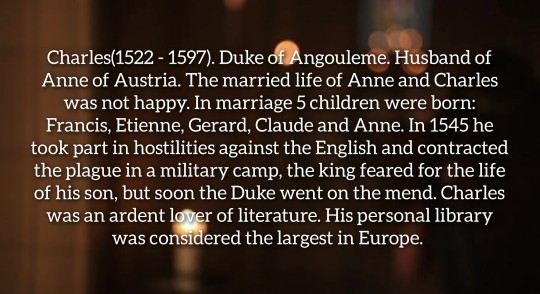
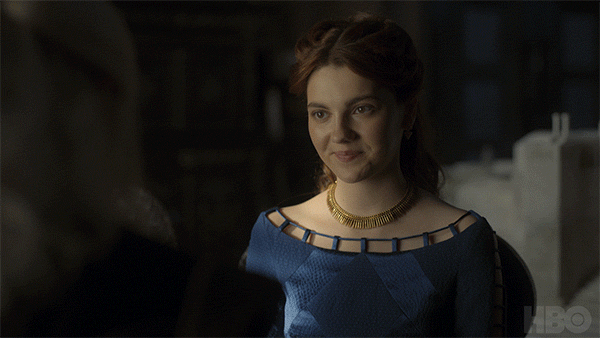
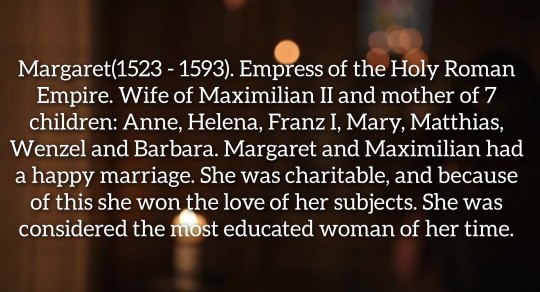
AU: Valois House. Children Francis I and Claude Valois.
Madeleine(1520 - 1583). Queen of Scots. Wife of James V and mother of 9 children: Kenneth IV, Duncan III, Mary, Malcolm, Margaret, Donald, Francis, Claude and Annabel. Madeleine and Jacob's marriage, was a happy one. Was very devout, patronized the church and helped the poor.
Charles(1522 - 1597). Duke of Angouleme. Husband of Anne of Austria. The married life of Anne and Charles was not happy. In marriage 5 children were born: Francis, Etienne, Gerard, Claude and Anne. In 1545 he took part in hostilities against the English and contracted the plague in a military camp, the king feared for the life of his son, but soon the Duke went on the mend. Charles was an ardent lover of literature. His personal library was considered the largest in Europe.
Margaret(1523 - 1593). Empress of the Holy Roman Empire. Wife of Maximilian II and mother of 7 children: Anne, Helena, Franz I, Mary, Matthias, Wenzel and Barbara. Margaret and Maximilian had a happy marriage. She was charitable, and because of this she won the love of her subjects. She was considered the most educated woman of her time
AU: дом Валуа. Дети Франциска I и Клод Валуа.
Мадлен(1520 - 1583). Королева Шотландии. Жена Якова V и мать 9 детей: Кеннет IV, Дункан III, Мария, Малькольм, Маргарита, Дональд, Фрэнсис, Клод и Аннабель. Брак Мадлен и Якова был счастливым. Была очень набожной, покровительствовала церкви и помогала бедным.
Карл(1522 - 1597). Герцог Ангулемский. Муж Анны Австрийской. Супружеская жизнь Анны и Карла была не счастливой. В браке родилось 5 детей: Франциск, Этьен, Жерар, Клод и Анна. В 1545 году принимал участие в боевых действиях против англичан и заразился чумой в военном лагере, кароль опасался за жизнь своего сына, но вскоре герцог пошёл на поправку. Карл был ярым любителем литературы. Его личная библиотека считалась самой большой в Европе.
Маргарита(1523 - 1593). Императрица Священной римской империи. Жена Максимилиана II и мать 7 детей: Анна, Хелена, Франц I, Мария, Маттиас, Венцель и Барбара. У Маргариты и Максимилиана был счастливый брак. Была милосердной, благодаря этому и завоевала любовь подданных. Считалась самой образованной женщиной своего времени.
Part 2.
#history#history au#royal family#royalty#au#french#french royal family#france history#france#french royalty#French royal#Royal#Roalty#Roy#French kings#French queens#French king#French queen#15th century#16th century#The reign#the serpent queen#the tudors#henryviii#mary tudor#francis i#Francisii#Henryii#catherine de medici#mary stuart
3 notes
·
View notes
Text
LOUIS-ANTOINE
Dauphin of France
(born 1775 - died 1844)

pictured above is a portrait of the Dauphin of France, by William Corden (the Elder) from 1847, after a portrait by Sir Thomas Lawrence from 1825
-------------------- ~ -------------------- ~ --------------------
SERIES - On this day August Edition: Louis-Antoine was born on 6 August 1775.
-------------------- ~ -------------------- ~ --------------------
LOUIS-ANTOINE was born on 6 August 1775, at the Palace of Versailles, during the reign of his uncle Louis XVI, King of France. He was the first child of Charles-Philippe, Count of Artois and Princess Marie-Thérèse of Sardinia. He was a member of the third HOUSE OF BOURBON also known as the Capetian House of Bourbon.
His name was LOUIS-ANTOINE D'ARTOIS because of his father's title. And after his birth his uncle created him DUKE OF ANGOULÊME, the title he was and still is most linked.
When the French Revolution arose in 1789 many Royals fled into exile to different parts of Europe and his immediate family initially took refuge in Turin with his mother's relatives.
By the end of the 18th century his uncle King Louis XVI was deposed and guillotined and another of his uncles Louis Stanislas, Count of Provence proclaimed himself as the Louis XVIII, King of France.
Soon, he and the remaining members of the exiled Royal Family were reunited in Courland (at that time governed by the Russian Empire, current in Latvia). While there he married his first cousin MARIE-THÉRÉSE CHARLOTTE in 1799. She was a Princess of France and the only surviving child of the late King Louis XVI and Archduchess Maria Antonia of Austria (known as Queen Marie Antoinette). They did not have children.
Over the next years the exiled French Bourbons had to leave Courland do to politics and lived in Poland, Russia and the United Kingdom.
Napoléon I, Emperor of the French was first defeated, forced to abdicate and exiled in 1814, and the Bourbons were allowed to return to France where the his uncle was officially recognized as the King of France.
However barely a year later Emperor Napoléon I fled from his exile and the Bourbons had to leave France, during what is known as the Hundred Days. By July 1815 the Emperor Napoléon I was defeated for good and the Bourbons returned to France once again.
In 1824 his uncle King Louis XVIII died and was succeeded by the Duke's father as Charles X, King of France. So as the French heir he became the DAUPHIN OF FRANCE.
But unfortunatley his father's reign lasted only until the July Revolution of 1830. At the beginning of August 1830 his father was forced to abdicate and on the same day he also renounced his rights of succession, ending the Bourbon French Monarchy forever.
He and his family were forced to live in exile again and could never return to France. While in exile the former Dauphin adopted the courtesy title of COUNT OF MARNES.
From 1832 the exiled Bourbons lived in the Austrian Empire, by favor of Emperor Franz I and his son Emperor Ferdinand I.
Both the former Dauphin and his father died in the town of Gorizia (at that time part of the Austrian Empire and now a comune in Italy). The Count of Marnes died aged 68, in 1844.
-------------------- ~ -------------------- ~ --------------------
As he did not have any children, his nephew Henri, Count of Chambord inherited the Bourbon claim to the French throne, known as Legitimist. However his nephew also died without heirs in 1883 and so the Spanish Bourbons became the Legitimists claimants to the French throne.
#louis antoine#duke of angouleme#dauphin of france#dauphin de france#kingdom of france#house of bourbon#bourbon#french royals#french royalty#french royal family#royal#royalty#monarchy#monarchies#royal history#french history#european history#world history#history#history lover#18th century#19th century#french revolution#louis xvi#marie antoinette#louis xviii#charles x#bourbon restoration#history with laura
6 notes
·
View notes
Photo

3 June 1844: Death of Louis Antoine, Duke of Angoulême, of sepsis at the age of 68. The son of the Count of Artois (later Charles X of France), he is less well known than his cousin and wife, Marie-Thérèse, the Duchess of Angoulême, who was the eldest child of Louis XVI and Marie Antoinette, and the only one of their offspring to survive the French Revolution.
The Duke was probably a disappointing husband. He lacked his father’s charm and manners, and had a sickly appearance. Even a partisan of the royal family said: “He is small, ugly and awkwardly built. He has very little brains and speaks in an uneducated manner.”
The Duke of Angoulême was widely thought to be impotent or homosexual, and there’s a good chance the marriage was never consummated. There were rumours, probably unfounded, that he ill-treated the Duchess. In public they were courteous to each other. Marshal Macdonald wrote: “[T]hose…who had opportunity for observation, noticed that the young couple were very affectionate and treated each other with the greatest deference and regard.”
When Charles X lost his throne in the July Revolution of 1830, he abdicated in favour of the Duke of Angoulême. The Duke reigned for 20 minutes as King Louis XIX of France before abdicating in favour of his nephew Henri, the Duke of Bordeaux. Unfortunately for the Bourbons, the Chamber of Deputies pronounced the Duke of Orléans (Louis Philippe) their new king.
The royal family went into exile. They lived first in Edinburgh, and then at the Castle of Hradschin in Prague. When Chateaubriand saw the Duke of Angoulême in 1833, he wrote: “I found him looking older and thinner. He was dressed in a shabby blue coat, buttoned high to the throat; it was too big for him and looked as if it had been bought at a second-hand shop; I felt terribly sorry for the poor Prince.”
The Duke and Duchess of Angoulême both remained greatly attached to Charles X and nursed him through his final illness and death. They lived an austere and monotonous life as trusted friends who shared each other’s sadness. They detached themselves from any political activity and turned increasingly to mysticism. The Marquis de Villeneuve observed: “[T]he couple had become august not only by sorrow nobly borne, but also by the strength of the bond between them, which included absolute leniency towards each other’s failings.”
Portrait of the Duke of Angoulême by Thomas Lawrence, 1825
#duke of angouleme#louis antoine#madame royale#house of bourbon#french history#otd#1844#thomas lawrence
25 notes
·
View notes
Photo
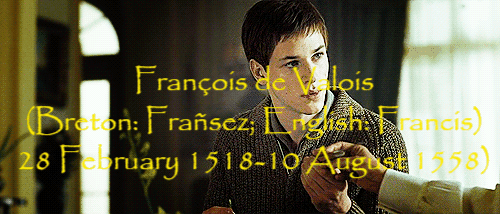

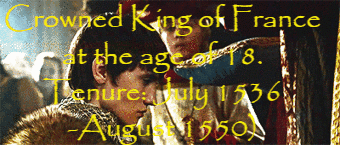

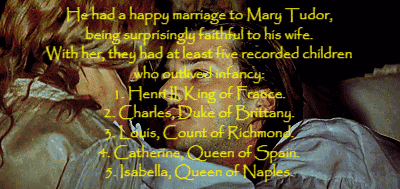

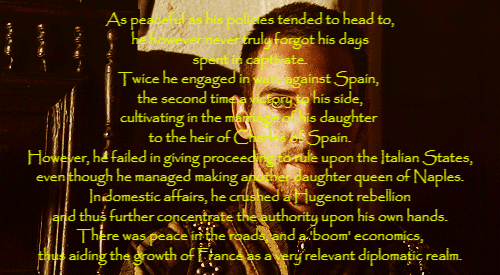
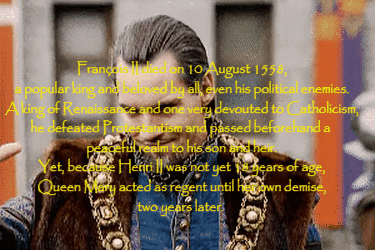
Tʜᴇ AU I·ᴅ ʟɪᴋᴇ ᴛᴏ sᴇᴇ﹐ ᴘᴀʀᴛ VII: Fʀᴀɴᴄ̧ᴏɪs II﹐ Kɪɴɢ ᴏғ Fʀᴀɴᴄᴇ.
[ 𝐺𝑎𝑠𝑝𝑎𝑟𝑑 𝑈𝑙𝑙𝑖𝑒𝑙 𝑎𝑠 𝐷𝑢𝑘𝑒 𝐹𝑟𝑎𝑛𝑐̧𝑜𝑖𝑠/𝑦𝑜𝑢𝑛𝑔 𝐾𝑖𝑛𝑔 𝐹𝑟𝑎𝑛𝑐̧𝑜𝑖𝑠 𝐼𝐼.
𝐽𝑜𝑛𝑎𝑡𝘩𝑎𝑛 𝑅𝘩𝑦𝑠-𝑀𝑒𝑦𝑒𝑟𝑠 𝑎𝑠 𝑜𝑙𝑑𝑒𝑟 𝐾𝑖𝑛𝑔 𝐹𝑟𝑎𝑛𝑐̧𝑜𝑖𝑠 𝐼𝐼 𝑜𝑓 𝐹𝑟𝑎𝑛𝑐𝑒.]
#Alternative History#historical au#François de Valois#Francis of Valois#Francis duke of Brittany#Duc de Bretagne#Francis III#François III#what if#son of#François I#Francis I#King of France#and#Claude of France#Queen Claude#House of Valois-Angouleme#House of Valois#Valois dynasty#Mary Tudor#Queen Mary I#Marie d'Angleterre#Tudor dynasty#House of Tudor#Tudors#The Tudors#Tudor#Gaspard Ulliel#as#Dauphin François
22 notes
·
View notes
Text
King Henri III of France

Team Henri III 6 Cm Round Badge
by CreativeHistory
#Henri III#King Henri#Valois#King of France#King of Poland#French king#Angouleme#Elizabeth I#mignons#Grand Duke of Lithuania#badge#history
1 note
·
View note
Text
1.3.1 proving to us all that Les Mis is a comedy first and foremost, a collection:
"The brilliant deed committed by M Lynch was that, being the mayor of Bordeaux on March 12, 1814, he had surrendered the city a little too soon to the Duke of Angouleme. Hence his peerage."
"The French Academy gave a prize theme, The Happiness Procured by Study. M Bellart was eloquent, officially."
"The bookseller Pelicier published an edition of Voltaire under the title Works of Voltaire, of the French Academy. 'That will attract buyers,' said the naive publisher."
"Dupuytren and Recamier quarreled in the amphitheater of the Ecole de Medicine, and shook their fists in each other's face, over the divinity of Christ. Cuvier, with one eye on the Book of Genesis and the other on nature, was endeavoring to calm reactionary bigotry by reconciling fossils with texts and making the mastodons support Moses."
Like this chapter does a wonderful job of portraying the frenetic energy of the Bourbon Restoration, and how much Paris stood at the crossroads. But it's also just really funny tbh.
17 notes
·
View notes
Text


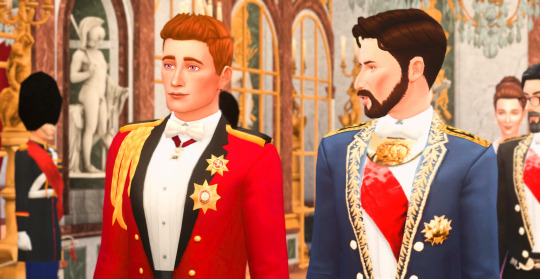
State Banquet at Versailles : Emperor Napoléon IV offers his royal guest the lair of the Sun King
For the first time during his reign, His Imperial Majesty received a foreign power at Versailles. Indeed, receiving guests at Versailles is extremely rare, so it was a matter of special attention from the Emperor. The Palace of Versailles is a place of power, French history and demonstration par excellence. A hundred guests are expected to attend the dinner in the famous Galerie des Batailles.
Duke Oliver of Rothsey appears adorned with the Order of the Legion of Honour, which he received from Emperor Napoléon IV earlier in the day. This lavish state dinner should allow the Francesim to assure its good feelings and support for the Scots kingdom. It is a very formal event, and under high surveillance: imperial guards, bodyguards, snipers, police… All the more so as the state dinner is filmed live.

The radiant Empress Marie-Joséphine walks with the Prime Minister, Charlemagne de Maupas. She wears the sapphire finery of the Duchess of Angouleme and the ribbon of the Legion of Honour.
The young guest duke, who will soon be joining the Polytechnic School with the Children of Francesim, will be able to experience the world-renowned French cuisine on his first day !
(Collaboration with @officalroyalsofpierreland)
TRADUCTION FR
Dîner d'État à Versailles : l'Empereur Napoléon IV offre à son hôte royal l'antre du Roi Soleil.
Pour la première fois durant son règne, Sa Majesté Impériale reçoit à Versailles une puissance étrangère. En effet, recevoir à Versailles est extrêmement rare, il s'agit donc d'une attention particulière de l'Empereur. Le château de Versailles est un lieu de pouvoir, d'histoire française et de démonstration par excellence. Une centaine d'invités sont attendus ce soir au repas à la célèbre Galerie des Batailles.
Le duc Oliver de Rothsey apparaît orné de l'ordre de la Légion d'Honneur, qu'il a reçu de l'Empereur Napoléon IV plus tôt dans la journée. Ce fastueux dîner d'État devrait permettre à la Francesim d'assurer ses bons sentiments et son soutien au royaume des Scots. Il s'agit d'un événement très protocolaire, et sous haute surveillance : gardes impériaux, gardes du corps, snipers, police... D'autant plus que le dîner d'État est filmé en direct.
La rayonnante Impératrice Marie-Joséphine marche en compagnie du Premier Ministre, Charlemagne de Maupas. Elle porte la parure saphir de la duchesse d'Angoulême et le ruban de la Légion d'Honneur.
Le jeune duc invité, qui rejoindra bientôt l'École polytechnique avec les enfants de Francesim, pourra faire l'expérience de la cuisine française de renommée mondiale dès son premier jour !
#simparte#ts4#gen 1#ts4 royal#royal simblr#sims 4 royal#sim : charles#sim : louis#royal sims#sim : oliver#sim : marie joséphine#versailles#galerie des glaces#ts4 royal legacy#state banquet
29 notes
·
View notes
Photo

Margaret of Angoulême, Duchess of Alençon and Queen of Navarre (11 April 1492 - 21 December 1549)
#margaret of angouleme#marguerite of navarre#duchess of alencon#queen of navarre#daughter of charles count of angouleme#married charles iv duke of alencon#then henry ii of navarre#history#women in history#france
2 notes
·
View notes
Text
sur la charente
From a source in the small village of Chéronnac, in the foothills of the Haute Vienne, the Charente River flows for 381 kilometres through the departments of Vienne, Charente and Charente-Maritime, in south-west France. It empties into the Bay of Biscay and the mud-brown swells of the North Atlantic just beyond the Napoleonic garrison town and bagne (penal colony) of Rochefort, from which many of the first French settlers of North America sailed.
The Charente’s lower reaches are an informal geographic, climatic and cultural demarcation between northern and southern Europe. Its banks, fringed with stands of oak and weeping willow, are littered with fragments of a chaotic history.
The shallow, gently flowing river was once described by the 16th century French king, Henri IV, as “the nicest stream in all my kingdom” but many of the battles that shaped the boundaries and character of Western Europe were fought along it: ancient Pictavi tribes against Roman legions (commanded by Julius Caesar himself); Franks and Burgundians against Andalucian Moors; English Plantagenet kings against French Valois kings; Roman Catholics against Huguenot Protestants; Napoleonic French against a coalition of English, Prussians, Austrians and Russians; and local resistance fighters against German Wehrmacht occupiers.
The full flowering of the French Renaissance was ‘watered’ from the Charente. Francois, son of Charles, Count of Angouleme and Duke of Valois, was born on the river’s banks, in the grand chateau of Cognac, in 1494. Twenty one years later, he was crowned King Francois Ier and became France’s first great patron of the arts and education. He brought Leonardo da Vinci from Italy (to re-design the interior of the Chateau Cognac, as well as to undertake several other important commissions) and established the core collection of Renaissance works preserved in Le Louvre.
Today, the land on either side of the Charente is sleepy, rural and overlooked – even if its best-known product, cognac, is a $US4.7 billion global business. The Charente’s picturesque medieval villages, chateaux, fortified barns and Romanesque churches are rarely visited by the several million foreign tourists that, every year, make their way through the region to the more fashionable villages of the Dordogne or the grand city of Bordeaux. But like the sweet-smelling, benign mould the local’s call “angel’s breath”, the by-product of alcoholic vapours that seep from fermenting cognac casks, history clings to everything here.
(These uncaptioned black and white photos were shot on an iPhone 4S while wandering slowly downriver — along tow-paths and vineyard tracks and over old stone bridges — between Angouleme and Cognac, in 2012.)










First published in Mr & Mrs Amos, Australia, 2013.
6 notes
·
View notes
Photo








If Elizabeth is betrothed to King Francis’s youngest son, the Duke of Angouleme, then her legitimacy and station would no longer be questioned by anyone.
#anneboleynedit#ndormeredit#perioddramaedit#TudorsEdit#anne boleyn#Natalie Dormer#the tudors#jonathan rhys meyers#King Henry VIII#gif#my gif#by me#2.06
312 notes
·
View notes














